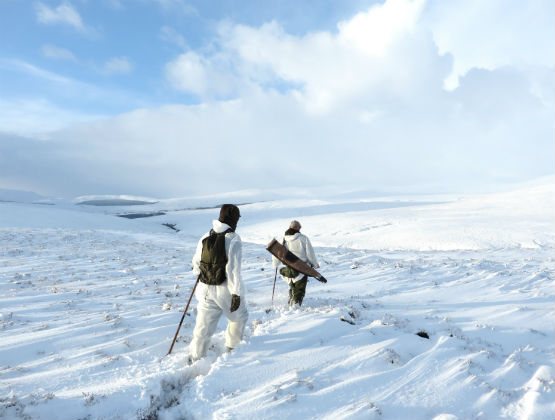What does the month of January hold in store for deer stalkers? Peter Jones takes a look.

(Above: Stalking in the Scottish Highlands where snow typically falls 100 days a year!)
Let it snow!....Ask a dozen deer stalkers about their most memorable winter stalks and you will surely find that a good number will mention snow.
Maybe it is the stark and vivid shift in the appearance of the landscape, or perhaps there is some cruel beauty in the appearance of a splash of crimson blood against the pure white snow.
Whatever the reason, deer stalking in these bleak conditions is a hugely memorable experience, indeed so much so that annually I have a number of clients who specifically request a call in the event of a covering.
Personally I have my own recollections of some striking snowscapes and have in fact only recently returned from a glorious and highly memorable trip stalking Red Hinds over a breathtaking, snow covered, highland hillscape. Blessed on the first day with the rare event of blue skies and deep snow, a handful of other CDS feature writers and I were rewarded with a dozen hinds and some of the most stunning scenery I have observed in some time, (an article and pictures are soon to follow).
Whether this type of stalking is routine for you or not, what is for sure is that in the event of snow or indeed a heavy frost, the successful deer stalker will need to change strategy. On the open hill first and foremost you should consider adorning winter whites to break up your outline and avoid sticking out like a sore thumb.
On the low ground you also need to re think your approach. In cold and windy weather deer will often be discovered sheltering amongst the trees and undergrowth. Indeed I recall a favourite stalking ground in the south east where we had a small forest of conifer, it was perhaps with unsurprising consistency that in the event of snow or hard frost, the Fallow deer could be found laid up on a warm bed of pine needles with the thick ever green canopy over head....and who could blame them.
Indeed, if before setting out you take just a moment to think to yourself: “Where would I take shelter?” You will be half way to a successful outing.
On to a few notable behavioural features; amongst the herding species of deer the male and females will have branched off into single sex herds and the highland reds will have returned to their home ranges. For those with Chinese Water Deer the December rut is now at an end, however with the season for both the Buck and Doe set to continue for another couple of months and with the pressure to feed intensifying, the stalker will find that this normally solitary deer will start to group around areas of good graze. As for the Roe, they too will now be found in well established family groups, the bucks will be in the early stages of antler growth and the does will start to exhibit the early signs of pregnancy after the initial delay in implantation.
And so another year begins and here at County Deer Stalking I am thrilled to announce that 2015 will be bringing with it some new and exciting changes....watch this space. In the mean time may I wish you all a prosperous and very happy new year!
 IN Season in England & Wales: Roe Does, Fallow Does & Fallow Buck, Sika Stags & Sika Hinds, Red Stags & Red Hinds, CWD Bucks & CWD Does, Muntjac Buck & Muntjac Does.
IN Season in England & Wales: Roe Does, Fallow Does & Fallow Buck, Sika Stags & Sika Hinds, Red Stags & Red Hinds, CWD Bucks & CWD Does, Muntjac Buck & Muntjac Does.
OFF Season in England & Wales: Roe Buck.
In Season in Scotland: Fallow Buck, Fallow Does, Roe Does, Sika Hinds, Red Hinds.
Off Season in Scotland: Red Stags, Sika Stags & Roe Buck



















